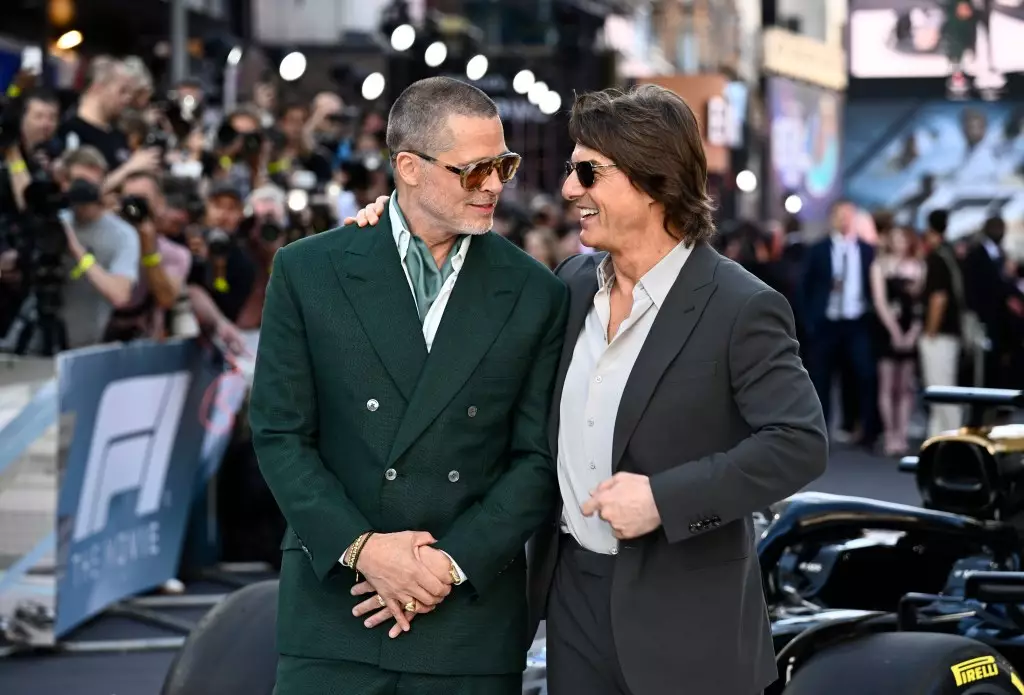Hollywood often crafts narratives of triumph and perseverance, but behind the glitz lies a tapestry of unmet expectations and abandoned projects. The story of Brad Pitt and Tom Cruise’s initial involvement in *Ford v Ferrari* exemplifies this disparity—an ambitious vision that flickered and faded before capturing audiences’ attention. Their early connection to the project was emblematic of Hollywood’s penchant for assembling star power before the script and execution align. It reveals a harsh reality: the dream of making that perfect racing film is often more about celebrity involvement than a genuine shared artistic vision.
Despite the film’s subsequent success, the behind-the-scenes struggles expose the precariousness of cinematic pursuits. The initial plans, which would have cast Cruise as Carroll Shelby and Pitt as Ken Miles, fell apart due to mutual dissatisfaction and internal studio conflicts. The actors’ desire to embody specific characters was thwarted by creative and logistical hurdles, demonstrating how personal aspirations often clash with institutional constraints. Hollywood’s narrative of bold innovation is frequently hampered by budgetary fears and risk aversion, especially when high-caliber projects threaten to spiral beyond anticipated costs. The failure to realize this particular vision underscores a broader truth: the movies that succeed on screen often conceal a labyrinth of compromises and dashed aspirations behind the scenes.
The Cost of Ambition: Financial Backing and Creative Control
Joseph Kosinski’s recounting of the original *Ford v Ferrari* project’s demise reveals a core issue that plagues Hollywood: budget overruns necessitate hard decisions. When studio executives prioritize controlling costs over creative authenticity, they inadvertently stifle artistic innovation. The $100 million-plus price tag for the initial vision made it a risky investment, particularly given the unpredictable nature of racing-themed films. Kosinski’s openness about studio objections illuminates the complex tension between artistic vision and commercial realities. This tug-of-war involves not just budgets but also the desire to shape narrative tone, focus, and casting choices, all of which influence the final product.
The failure of this ambitious project exemplifies how studio considerations—fear of financial loss, marketability, and brand branding—often dominate creative choices. In Hollywood, lucrative formulas and safe bets tend to overshadow artistic risk-taking. The lost opportunity for a truly groundbreaking racing film reveals how the industry’s structural biases stifle innovation. We are left to wonder what could have been if studios had prioritized artistic integrity over short-term profits. Instead, the result is a sanitized, albeit successful, film that, despite accolades, remains a simplification compared to the sprawling complexity of true racing stories.
The Illusion of Control: Why Hollywood’s Projects Often Fall Short
The behind-the-scenes turbulence underscores Hollywood’s reliance on control—control over budgets, narratives, and ultimately, audiences’ perceptions. When filmmakers like Joseph Kosinski acknowledge that studio objections and financial constraints derailed their vision, it becomes evident that Hollywood’s creative ecosystem is riddled with compromises that dilute original intent. The industry’s obsession with safe projects and risk-averse strategies frequently curtail the raw energy and authenticity that make for truly memorable cinema.
Furthermore, the recent chatter about a potential *Ford v Ferrari* sequel, spawned by director Kosinski’s comments, demonstrates Hollywood’s ongoing obsession with franchise-building and continuity. Yet, this obsession risks further diluting stories that initially could have been potent, nuanced portrayals of courage and innovation. It exposes an industry caught in a self-perpetuating cycle—chasing the next big franchise rather than cultivating genuine artistic mastery. Hollywood’s so-called “control” over projects often equates to mediocrity, with the essence of stories sacrificed for the promise of commercial longevity.
Hollywood’s Obsession with the Illusive “Perfect” Race Film
From Pitt’s and Cruise’s early ambitions to Kosinski’s unfulfilled vision, the recurring theme is a relentless pursuit of the ideal racing film—one that captures adrenaline, drama, and authenticity. Yet, the industry’s inability to deliver consistent, compelling stories reveals its underlying insecurity: investors and studios prefer formulaic comfort over bold storytelling. The myth of Hollywood as a hub of creative freedom is often just that—a myth.
The broader cultural implications suggest that Hollywood’s racing films are less about celebrating the sport’s raw power and more about spectacle, polished and predictable. It is ironic that genuine stories of grit, innovation, and risk—like those at the core of racing—are often sacrificed on the altar of commercial ease. Meanwhile, actors and directors, despite their talent and passion, find themselves thwarted by the system’s limits. The story of Hollywood’s racing films is ultimately a reflection of a larger truth: that creative control, much like racing itself, is a fragile illusion, easily lost to the chaotic forces of commerce and institutional caution.

